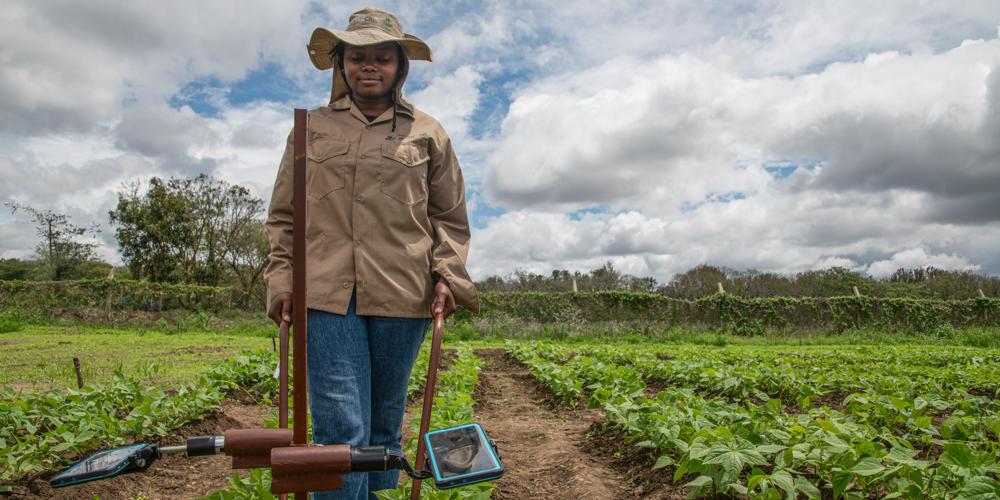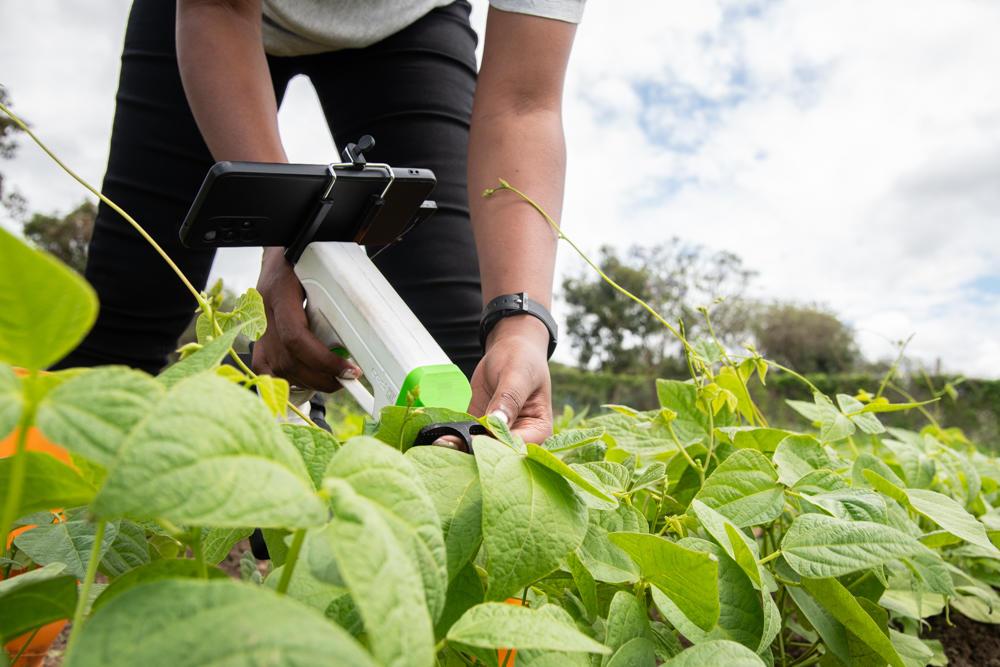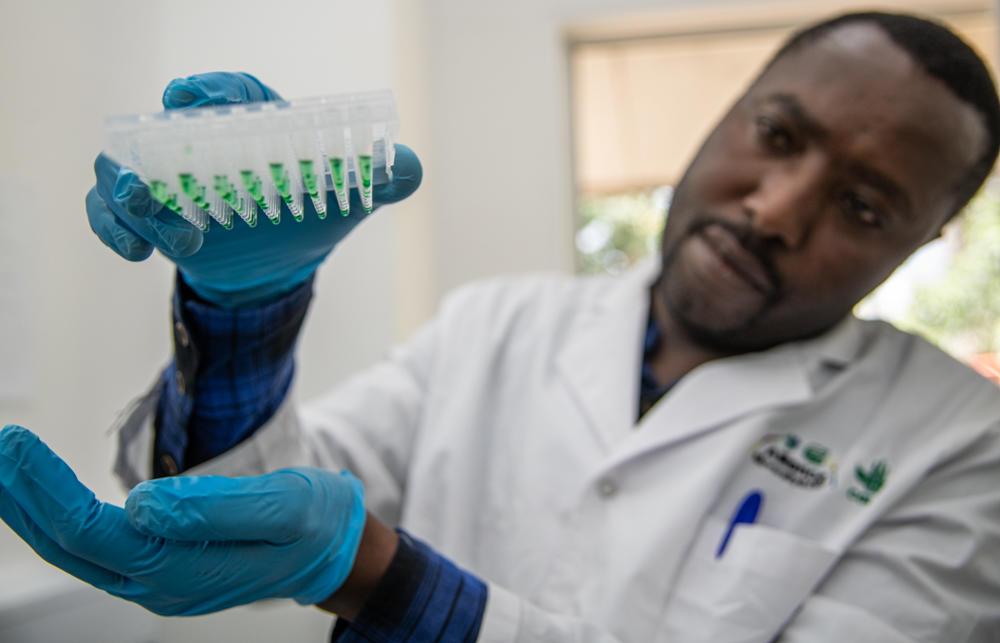From the Field Bruno and Yellow Beans: Artificial Intelligence in the Field

On World Pulses Day, learn how climate smart bean breeding is being achieved in Tanzania through a combination of cutting-edge and low-tech innovation.
By: Georgina Smith
Heat bounces off the rocks as Bakari Hamisi Sumawe leads the way to his bean field. It is not a short walk. Navigating steep rock inclines and thick forest pathways, it takes around an hour to reach his plot.
“Why did we farm in a valley?” he reflects. “Because there’s a reliable supply of water for irrigation. There’s always a possibility of a good harvest because of the constant supply of water,” he explains.
Common bean plants need water to flower. Without water, from irrigation sources or from rain, the flowers abort. Fewer flowers are then converted into pods, and that translates into lower yield.
In a twist of cruel irony so often associated with climate change, Sumawe faces another problem: too much rainfall. “When the rain is too much to harvest, it is hard to store [the beans]. It’s costly, the costs become more than the production,” he explains.
Edith Kadege, a plant pathologist at the Tanzania Agriculture Research Institute, picks up a rotting bean trapped in water. Over the years, TARI has released more than 30 improved bean varieties to help farmers beat drought or combat flooding.
“When we develop a variety, it cannot stay on our shelf,” she explains. “After developing the new, improved, drought-resistant or disease resilient beans [with partners], we multiply them and work with seed companies to ensure farmers can get them.”
But, she says:
“With climate change, varieties developed now could be unhelpful in two to three years when new pathotypes emerge. So, the breeding process has to be continuous to support farmers.”
Hours from Bakari’s plot, at TARI partner the Alliance of Bioversity International and CIAT’s trial farm, researchers are working on a project called Artemis, which is using Artificial Intelligence (AI) to speed up breeding.

Farmer Bakari Hamisi Sumawe in Karatu, Arusha, Tanzania
Dr. Stephen Mutuvi, Machine Learning Researcher explains: “We all know computers can process data in a very short time, things that a farmer can’t do, for example going to the field and counting every pod in every plot every day, it’s almost impossible.
“But with computers we can quickly take images using computer vision technologies and analyze data in a very short time, throughout the season. It is important to see how things change across the season – something AI is able to help us do.”
“With machine learning, we are able to “show” computers traits of importance such as flower count, pod count, so they can recognize and count them. The goal is to have models deployed in mobile phones or portable devices accessible to farmers and breeders at national level around the world.”

Collecting digital data for AI breeding models with Bruno, at the Alliance of Bioversity International and CIAT field trials in Arusha, Tanzania.
In a field of recently bred yellow beans, Dr. Teshale Mamo, relates how over the years, new beans have been bred to become drought and heat tolerant; disease and pest resistant; high yielding with short cooking times and more nutritious, containing high iron and zinc.
For example, the KAT B-1 or Selian 14 yellow bean is in big demand in East Africa for its low flatulence, good taste and short cooking time among customers; and among farmers, its ability to command a high price. But it has weakness: it is susceptible to disease and is low-yielding.
For the last three years, Dr. Mamo has been cross-breeding the popular yellow beans with higher yielding, disease-tolerant varieties from Colombia – where the Alliance of Bioversity International and CIAT operates the largest genebank for beans. The new varieties will be tested in different locations and made available to National Research Stations across Africa.
The cross-breeding process took three years because “phenotyping,” identifying traits like how many flowers plants have, was done manually. Generally, to collect enough data to understand how plants respond to the environment, breeding takes five years or more.

Collecting digital data for AI breeding models to detect disease, at the Alliance of Bioversity International and CIAT field trials in Arusha.
Artificial Intelligence-based phenotyping can speed-up the breeding cycle by 50%. “With food security pressures, speeding up the breeding processes will help us get new varieties to increase productivity on farms,” says Dr. Mamo.
Meet Bruno: a digital tool made from bicycle parts and selfie sticks, and other easily accessible local materials that could fix a bike, microwave or radio. With two android phones strapped to its sides, it can quickly capture data like number of pods in seconds.
Artemis Data Analyst Ellena Girma explains: “As a breeder, if my goal is to count the number of pods in a field, which would help indicate the yield potential of a variety, traditionally I may only be able to select 5-10 plants that would become representative of that specific plot.
“At plot 10, I might be hot and tired”, and breeding programs can have 100s to 1,000s of plots. “But any inaccurate data collection would translate into errors in the performance of varieties. More trials would need to be done for accuracy.”

Checking bean plant DNA in the molecular lab to determine specific traits like drought resilience at the Alliance of Bioversity International and CIAT.
“Quality data, for example exact number of pods, leads to faster decision-making,” Girma explains. At the same time, things like bean disease are hard to measure. When it comes to putting disease on a scale of 1-9, what constitutes a 4 over a 5? Humans are just not as good as computers at collecting and analyzing data objectively and with minimal error.
Computers can be trained to select flowers or pod images and calculate the amount to infer potential yield in minutes. This would take weeks or months if left to humans. With Bruno, full plots can be analyzed in seconds.
That is good news for farmers like Sumawe. If the breeding process can be fast-tracked, smallholder farmers can have faster access to beans that can beat new climate challenges. And with improved digital technology, they can also advise what traits to breed for.
Especially in sub-Saharan Africa, where the number of farmers is large and the number of extension officers and breeders is small, researchers working on the Artemis project believe that AI can bridge that knowledge gap in future.
The Team

Teshale A. Mamo
Bean Breeder, Country Representative for Tanzania



